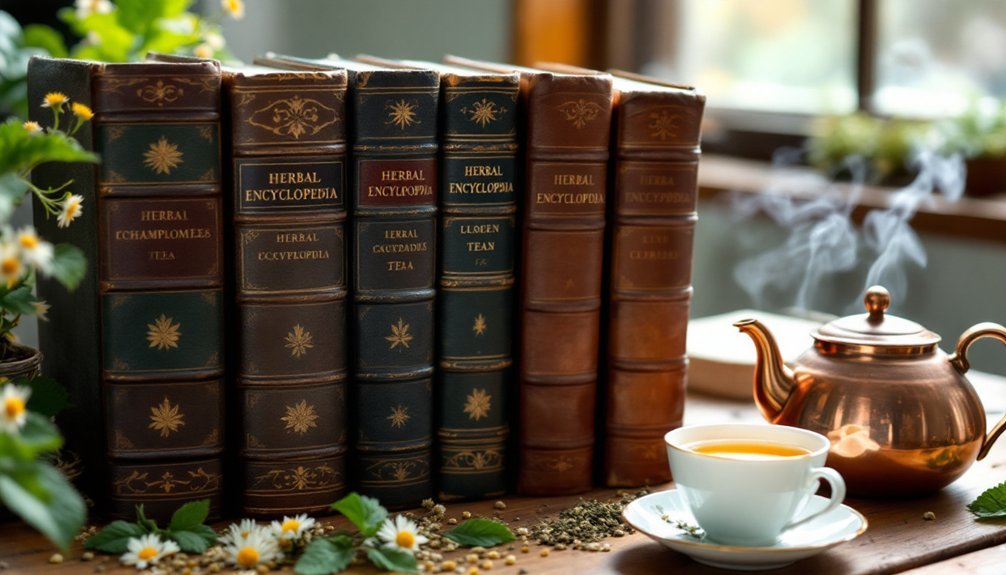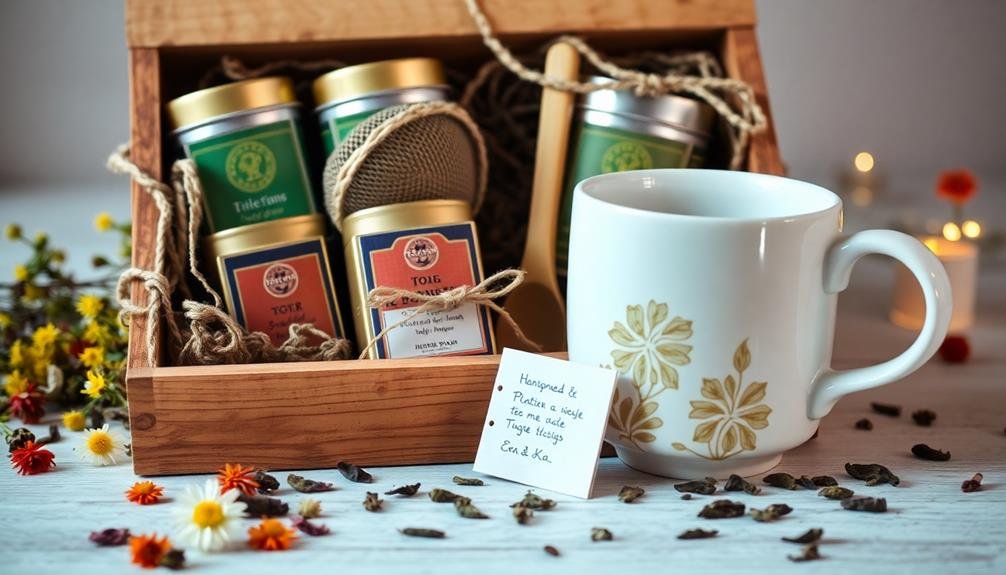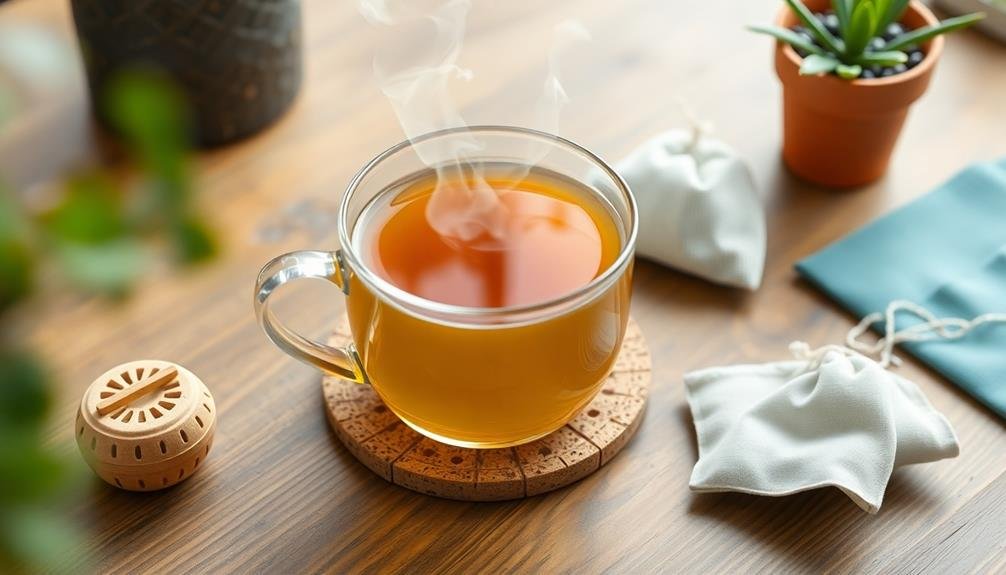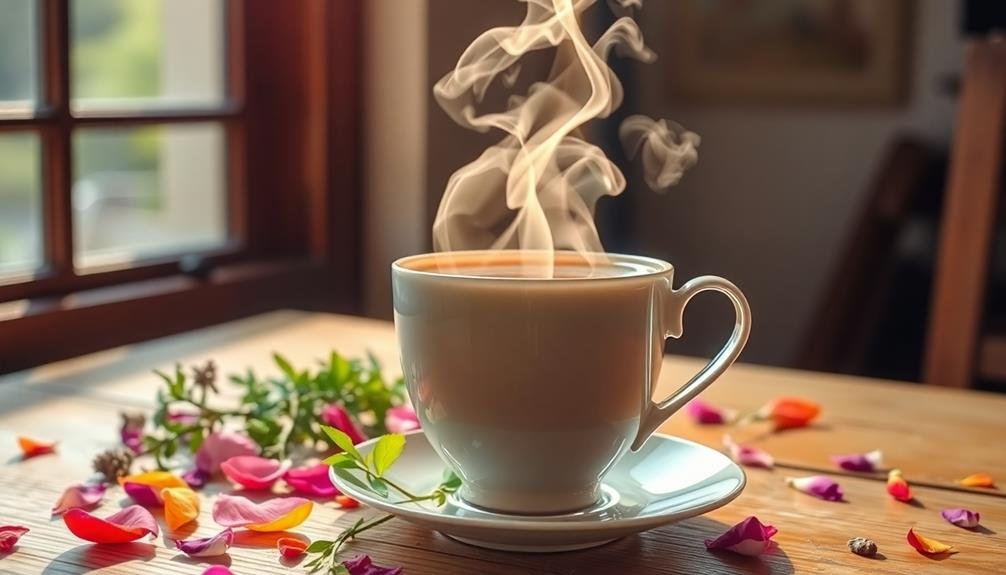You'll find that selecting the right herbal encyclopedia can transform your tea-making journey from guesswork to mastery. Whether you're just starting out or you've been crafting herbal blends for years, having trusted resources at your fingertips makes all the difference. Master herbalists have identified five essential reference guides that stand out from the rest, each offering unique insights into the art and science of herbal tea preparation. Let's explore what makes these particular books indispensable to both novice and experienced tea crafters.
DK Encyclopedia of Herbal Medicine: 550 Herbs and Remedies
The DK Encyclopedia of Herbal Medicine stands out as an ideal reference for visual learners and beginners venturing into herbal tea crafting, while serving as a thorough guide for botany students.
You'll find detailed instructions for creating teas, tinctures, oils, and salves, accompanied by high-resolution photographs that enhance your learning experience. The encyclopedia covers 550 herbs and includes valuable historical context about herbal medicine. While you'll need to navigate through scientific names and use the index to locate specific herbs, the wealth of information and practical applications make it worth the effort. The book's quality printing and extensive content deliver excellent value, though you might want to supplement the herb photos with online resources.
Best For: Visual learners, botany students, and beginners interested in herbal medicine who want a comprehensive, well-illustrated guide to creating natural remedies.
Pros:
- Extensive coverage of 550 herbs with detailed instructions for making teas, tinctures, oils, and salves
- High-quality, detailed photographs and illustrations that enhance learning
- Well-organized information including historical context and medicinal uses
Cons:
- Herbs are organized by scientific names rather than common names, requiring frequent index use
- Not all herbs include photographs, necessitating additional research
- Large format makes it impractical for portable reference use
Rosemary Gladstar's Medicinal Herbs: A Beginner's Guide
Beginners seeking an all-encompassing yet approachable guide to herbal tea-making will find Rosemary Gladstar's Medicinal Herbs: A Beginner's Guide invaluable. You'll discover clear instructions for creating teas, syrups, tinctures, and other herbal preparations using 33 common herbs.
What sets this book apart is its practical, user-friendly approach. You'll need only basic kitchen equipment to get started, and the detailed recipes like Rosemary-Lemon Thyme tea are easy to follow. The book's beautiful photos and thoughtful organization make it simple to locate information, while Gladstar's engaging writing style feels like learning from a trusted mentor. It's an excellent resource for incorporating natural remedies into your daily wellness routine.
Best For: Beginners interested in learning about medicinal herbs and making simple herbal remedies at home who want a practical, approachable guide with clear instructions and basic recipes.
Pros:
- Clear, easy-to-follow instructions with detailed recipes for 33 common herbs
- Requires only basic kitchen equipment, making it accessible for newcomers
- Beautiful photography and well-organized content with an engaging, personal writing style
Cons:
- Limited to only 33 herbs, which may not cover all herbs of interest
- Focuses primarily on basic preparations, may not satisfy those seeking advanced techniques
- Some recipes and treatments may require ingredients not readily available in all areas
The Modern Herbal Dispensatory: A Medicine-Making Guide
Experienced herbalists seeking extensive medicine-making guidance will find immense value in The Modern Herbal Dispensatory. While it's not primarily focused on tea making, this advanced guide offers a wealth of recipes and extraction methods that you'll find useful in your herbal practice.
You'll appreciate the book's concise descriptions and easy-to-navigate format, though you'll need to rely on other resources for visual references. If you're already familiar with herbs, you'll benefit from the practical tips and nuanced insights the authors provide. Despite its preference for alcohol extracts and occasional recipe inconsistencies, it's an essential addition to your herbal library, especially when cross-referenced with other texts.
Best For: Experienced herbalists and intermediate-level practitioners seeking comprehensive medicine-making recipes and techniques who already possess basic herb knowledge.
Pros:
- Extensive collection of herbal remedies and extraction methods presented in an easy-to-navigate format
- Offers practical tips and nuanced insights from experienced practitioners
- Serves as an excellent reference guide with concise, informative descriptions of medicinal actions and uses
Cons:
- Lacks pictures and visual references that could aid in learning
- Shows a notable preference for alcohol-based extracts over other extraction methods
- Contains some typos and recipe inconsistencies that might confuse newer practitioners
Healing Herbal Teas: 101 Specially Formulated Tea Blends
Readers seeking thorough herbal tea formulations will find exceptional value in Sarah Farr's "Healing Herbal Teas: 101 Specially Formulated Tea Blends." This detailed guide combines traditional wisdom with practical applications, offering solutions for stress management, seasonal wellness, and immune support.
You'll discover extensive recipes that balance flavor with therapeutic benefits, making even challenging herbs palatable. Whether you're dealing with autoimmune issues, chronic fatigue, or depression, Farr's empathetic approach provides safe, natural alternatives. The book also guides you through starting an herb garden, including harvesting and storage techniques. While some ingredients require specialty sourcing, the long-term benefits of crafting your own blends make this resource invaluable.
Best For: Wellness enthusiasts and health-conscious individuals seeking to create their own therapeutic tea blends, particularly those interested in natural remedies and herbal medicine.
Pros:
- Comprehensive collection of 101 well-formulated tea blends with clear therapeutic benefits
- Includes practical guidance for growing and harvesting your own herbs
- Written with an empathetic approach that makes herbal medicine accessible to beginners
Cons:
- Some ingredients may be difficult to source from regular grocery stores
- Initial investment in herbs and supplies can be costly
- May require significant time commitment to grow and prepare herbs properly
Tincture Recipe Book: Complete Guide to Natural Herbal Remedies
The Tincture Recipe Book stands out as an essential guide that'll transform your understanding of herbal remedies through its dual-section approach. You'll find 20 common herbs in the beginner section, complete with clear preparation methods and helpful illustrations.
In the advanced section, you'll discover both common and exotic herbs, plus mushrooms, with detailed tincture-making instructions. Each recipe spans two pages, making it easy to follow without constant page-turning. You'll appreciate the thorough health section that covers dosage, contraindications, and specific herb recommendations for various ailments. The hardcover edition's stunning design makes it both practical and collectible.
Best For: This book is ideal for beginners interested in herbal medicine and experienced herbalists seeking comprehensive tincture recipes and health applications.
Pros:
- Clear dual-section structure with beginner-friendly and advanced content
- Comprehensive health information including dosage and contraindications
- Well-organized two-page recipe layout prevents constant page flipping
Cons:
- Limited to 20 common herbs in the beginner section
- May be too basic for experienced herbalists in the beginner section
- Hardcover edition may be more expensive than paperback alternatives
Factors to Consider When Creating an Herb Encyclopedia for Tea Making
When you're creating an herb encyclopedia for tea making, you'll need to balance essential components like detailed plant identification, clear recipe formatting, and thorough safety guidelines. You'll want to include high-quality photographs and illustrations that help readers identify herbs correctly and understand proper preparation techniques. Seasonal growing information rounds out your encyclopedia by helping readers plan their herb gardens and harvest times effectively.
Herb Identification and Detail
Creating accurate and detailed herb identification guides stands as the cornerstone of any thorough tea-making encyclopedia. You'll need essential details like scientific names, common names, and extensive growing conditions to guarantee you're selecting the right herbs for your tea blends.
When evaluating herb encyclopedias, look for high-resolution photographs that clearly show distinguishing features of each plant. This visual guidance helps you avoid confusion between similar-looking herbs that may have vastly different properties. The best guides will also include specific information about harvesting times, drying methods, and proper storage techniques to maintain your herbs' potency. Additionally, you'll want clear instructions on dosage and preparation methods to guarantee you're making safe, effective tea blends that maximize their health benefits.
Recipe Format and Organization
Successful herb encyclopedias rely on five key elements of recipe format and organization to enhance their usability. You'll want clear, step-by-step instructions that guide beginners through the tea-making process without confusion. The best encyclopedias organize their recipes by practical categories like health benefits or seasonal blends, making it easier to find the perfect tea for your needs.
Look for books that include helpful visual aids alongside recipes – illustrations and photographs can dramatically improve your understanding of preparation techniques and ingredient identification. Essential details like dosage, prep time, and required equipment should be clearly listed for each recipe. Don't overlook the importance of a thorough index and well-structured table of contents, as these features let you quickly navigate to specific recipes when you're ready to start brewing.
Visual Learning Components
Visual components serve as powerful tools that transform complex herbal information into easily digestible knowledge for tea enthusiasts. When you're browsing herb encyclopedias, look for high-resolution photographs that clearly show each plant's distinctive features, making identification straightforward and reliable.
You'll benefit most from encyclopedias that include illustrated step-by-step guides for tea preparation techniques. The best resources feature colorful layouts and engaging infographics that break down complex information about herbal properties and uses. These visual aids help you quickly grasp essential concepts without getting overwhelmed by text-heavy descriptions.
Don't overlook the importance of a well-structured visual index. It'll help you locate specific herbs and recipes efficiently, saving valuable time as you explore the world of herbal tea making.
Safety Information Coverage
Safety information stands as a cornerstone of any reliable herb encyclopedia for tea making, as it protects users from potential adverse effects while ensuring responsible consumption.
When evaluating an herb encyclopedia, you'll want to verify that it thoroughly covers potential side effects and lists specific contraindications for various health conditions. The guide should provide clear dosage guidelines and usage durations, helping you avoid overconsumption. Look for detailed information about herb-medication interactions, as certain combinations can be dangerous.
A quality encyclopedia won't just focus on the herbs themselves but will also emphasize the importance of sourcing from trustworthy suppliers to prevent contamination risks. Most importantly, it should stress the need to consult healthcare professionals before starting any herbal tea regimen, especially if you're managing existing health conditions.
Seasonal Growing Guidelines
While many tea enthusiasts focus on brewing techniques, understanding seasonal growing guidelines proves vital for cultivating your own herbs. You'll need to know when to plant specific varieties – mint and chamomile thrive when planted in spring, while echinacea and lavender do best in early summer.
Your local climate plays an important role in determining your growing season. If you're in a warmer region, you can grow herbs year-round, but cooler areas restrict you to shorter growing windows. You'll want to monitor your local temperature and rainfall patterns, as these factors directly impact your herbs' potency and growth success.
When developing your herb garden, timing your harvest is critical. Picking herbs at their peak guarantees you'll get the most robust flavors and strongest medicinal properties for your teas.
Preparation Method Instructions
Precise preparation instructions form the backbone of any reliable herb encyclopedia for tea making. You'll want to look for guides that break down each step clearly, making it easy to follow even if you're new to herbal tea crafting.
The best encyclopedias include specific herb-to-water ratios for different blends, ensuring you'll achieve ideal flavor and potency. They should detail essential brewing variables like steeping times and water temperatures, which directly affect how well you'll extract the herbs' beneficial properties. Look for resources that feature clear photographs or illustrations of the preparation process, as these visual aids will improve your technique.
Don't overlook sections on herb combinations and safety precautions. Quality encyclopedias will guide you through combining herbs effectively while warning about potential interactions with health conditions.
Frequently Asked Questions
How Long Can Dried Herbs Be Stored Before Losing Their Medicinal Properties?
You'll want to use your dried herbs within 1-2 years for ideal medicinal benefits. While they won't spoil, they'll gradually lose potency over time. Store them in airtight containers away from light and heat.
Can I Grow All These Herbs Mentioned in the Encyclopedias Indoors?
You can grow many herbs indoors, but not all will thrive. Most culinary herbs like basil, mint, and thyme do well with proper light and care. Some medicinal herbs need outdoor conditions to flourish.
Are There Any Herbs That Should Never Be Combined in Teas?
You'll want to avoid mixing St. John's Wort with other medications, and don't combine certain sedative herbs like valerian and kava. Also, be careful with licorice root as it can interact dangerously with other herbs.
What's the Best Time of Day to Harvest Herbs for Tea?
You'll get the best results harvesting herbs in the early morning after the dew has dried but before the day heats up. This timing helps preserve the plants' essential oils and therapeutic properties.
How Do Different Water Temperatures Affect the Potency of Herbal Teas?
You'll get the best results using water temperatures between 160-212°F. Delicate herbs need cooler water (160-180°F), while woody herbs and roots require hotter temps (190-212°F) to release their medicinal properties effectively.





Leave a Reply